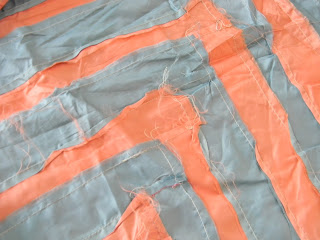I have a quilt top that reminds me of change, and how it is possible that change doesn't always work out for the best.
It was described on the estate sale tag as a "silk coverlet". It is neither silk, nor a coverlet. It is a machine pieced quilt top with nylon fabric.
Nylon was first introduced at the World's Fair in New York in 1939. It was the part of the innovation of synthetic fabrics - nylon to replace silk - and promoted at the fair for replacing silk for the production of ladies stockings. The production of nylon went to the war effort in the 40's and it was used for parachutes for the troops; functional and more economical than silk.
At first glance, this quilt top looks like an Amish framed square pattern, except in a pink and blue colorway popular during the 40's.
 |
| The nylon strips measure 1 3/4" wide. Forgive the wrinkles, I'm not brave enough to press this top. |
 |
| The top is on a full size bed. The top measures approximately 87" square. |
 | |
|
I keep thinking about the top and I am often glad it was never made into the "coverlet" or quilt or anything covering one sleeping. Think about the 1940's when smoking in bed was commonplace. Nylon melts when it is heated. Not only does it melt, but it adheres to the surface of the object making contact and this disastrous scenario would end with the individual caused more severe burns than an organic/natural produced fiber bedding (which would burn and turn to ash).
But back to assembling this top. I am amazed. I had sewn with nylon in my youth and vowed never again. Pressing was a nightmare. I never selected the proper size needle so holes wouldn't appear, and keeping the slippery surfaces from shifting was just too much for a young, inexperienced seamstress to handle. A few dresses ended up wadded up in bags thrown in my closet which meant I had wasted my allowance money without anything to show for it. So for this top to be quite straight and uniform means an experienced or very patient seamstress loving assembled the new fabric of the future.
I never really considered making a quilt of synthetic fabrics. Synthetic fabrics don't appeal to me mainly because they aren't comfortable. I get hot and sticky in hot weather because they don't breathe like natural fibers. In the winter, I feel cold because they don't retain body heat.
Double knits? Oh, that's another synthetic nightmare of the 60's and 70's right along with a fashion malady called "Hot Pants".












